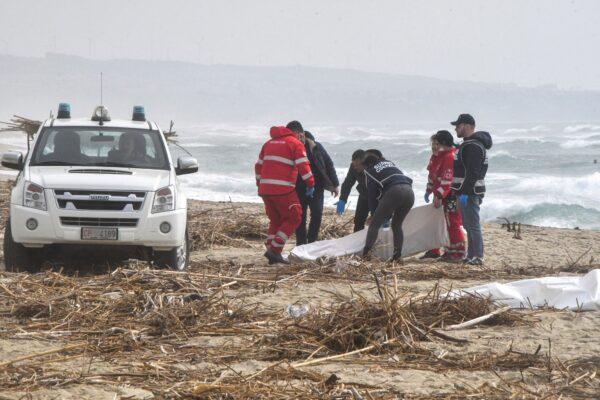EU Approves Major Reforms to Immigration Policies
The EU’s new migration and asylum pact introduces updated screening rules that encompass identification, health and security evaluations, and the collection of biometric data.
European Union (EU) legislators endorsed a revamped immigration system on April 10 following extensive negotiations over several years.
Members of the European Parliament (MEPs) ratified the new Migration and Asylum Pact, aimed at overhauling the EU’s immigration legislation, aligning with its member nations to effectively manage unlawful immigration into the union, according to an official statement.
This initiative was crafted in response to the influx of 1.3 million individuals, primarily fleeing conflict in Syria and Iraq, who sought refuge in Europe in 2015. The EU’s asylum infrastructure crumbled, reception centers in Greece and Italy were overwhelmed, and northern countries erected barriers to deter unauthorized immigrants.
As of this year, over 46,000 individuals have entered the EU unlawfully, with estimates from the U.N. suggesting that 400 individuals lost their lives while attempting to enter.
‘Mandatory Solidarity’
The legislation outlines a “new mandatory solidarity mechanism” that mandates all EU members to aid others that are inundated by substantial unlawful immigration, as per the bill’s text and the official statement.
Under this mechanism, the EU will create an annual pool to which each member state must contribute either by relocating illegal immigrants to its territory or through a financial contribution, the statement explained.
The calculation of the annual contribution is based on a weighted average of the country’s proportion of the total population and GDP within the 27-member bloc, as stipulated in the legislation, with each share holding a 50% weight.
For instance, if a member country constitutes 20% of the EU population and 10% of the bloc’s GDP, then its weighted average contribution would be 15%, calculated as half of the population share and half of the GDP share.
Although the member country must fulfill its allocated quota, it retains the freedom to choose the form of contribution, whether relocating illegal immigrants or covering costs for other EU nations to accept immigrants, as outlined in the bill.
The legislation also sets a minimum contribution threshold, requiring each member country to process at least 30,000 immigrants and contribute €600 million ($640 million) annually.
EU member states are also permitted to provide assistance to non-EU nations directly impacted by migration flows towards the EU, according to the official statement.
Response to Immigration Crises
The bill mandates that all member states contribute to supporting an EU member facing a dysfunctional immigration and asylum system due to a substantial influx of illegal immigrants via land, air, or sea, as per the statement and the bill text.
This provision also addresses the issue of “instrumentalization of migrants,” the statement highlighted.
Instrumentalization occurs when a third country or hostile non-state entity exploits an immigration scenario and encourages or facilitates movement to the EU’s external borders with the aim of destabilizing the EU or its member states, the statement maintained. However, it clarified that humanitarian aid operations should not be considered forms of instrumentalization as their objective is not to destabilize the EU or its constituents.
Screening at EU Borders
The legislation incorporates new screening protocols that encompass identification, health and security screenings, and the collection of biometric data, as stated in a press release.

The current EU fingerprint processing system, Eurodac, will be upgraded to include storage and processing of facial images and additional information for illegal immigrants and asylum seekers, as detailed in a press release. Additionally, the legislation has reduced the age threshold for the collection of biometric data from children, lowering it from 14 to 6 years.
Established in 2000, Eurodac can be accessed by the EU police (Europol) and the national police forces of all member nations, as well as four non-EU countries—Iceland, Norway, Switzerland, and Liechtenstein.
Asylum and Deportation Procedures

The bill enforces a timeframe of up to 12 weeks for asylum procedures conducted at or near the EU’s external border or transit zones, with rejected asylum seekers mandated to be deported within 12 weeks, according to the regulation.
Unlawful immigrants are entitled to free legal assistance in all administrative proceedings, the statement emphasized.
Reception of Asylum Applicants
Children are to be enrolled in school within two months of arrival, while unaccompanied minors must be assigned a guardian shortly after applying for asylum, the statement disclosed.
EU Resettlement Program
How MEPs Voted
The new Migration and Asylum Pact comprises ten legislative components, each evaluated and approved individually, as outlined in the statement.
Segments of the bill addressing crises stemming from high levels of unlawful immigrants were endorsed by a slim margin of 29 votes, with 46 abstentions. The sections affecting asylum procedures were passed with a close margin of 32 votes and 51 abstentions, according to the statement.
Conversely, the segment addressing the resettlement program was approved with a significant 300-vote margin and 14 abstentions, the statement added.
The parts concerning the management of asylum seekers and the expansion of the EU’s centralized biometric system prevailed with wide margins of 236 and 232 votes, respectively, the statement noted.
To become law, the bill requires approval from the EU Council, another legislative body.
Implementation of the regulations is set to commence in two years, with member states given a two-year timeframe to incorporate changes into their national laws regarding immigrant reception, stated in the release.
Controversies
The parliament’s proceedings were briefly disrupted by a group of demonstrators in the public gallery wearing shirts with the message “this pact kills” and vocalizing “Vote no!”
Eve Geddie, director at Amnesty International, remarked, “This is a failure to exhibit global leadership on refugee protection and develop secure, impartial, and dignified avenues for individuals to access Europe, be it in search of safety or opportunity.”
Contributions from The Associated Press and Reuters.





